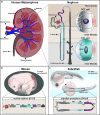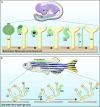(Zebra)fishing for nephrogenesis genes
- PMID: 37254823
- PMCID: PMC11042071
- DOI: 10.1080/21688370.2023.2219605
(Zebra)fishing for nephrogenesis genes
Abstract
Kidney disease is a devastating condition affecting millions of people worldwide, where over 100,000 patients in the United States alone remain waiting for a lifesaving organ transplant. Concomitant with a surge in personalized medicine, single-gene mutations, and polygenic risk alleles have been brought to the forefront as core causes of a spectrum of renal disorders. With the increasing prevalence of kidney disease, it is imperative to make substantial strides in the field of kidney genetics. Nephrons, the core functional units of the kidney, are epithelial tubules that act as gatekeepers of body homeostasis by absorbing and secreting ions, water, and small molecules to filter the blood. Each nephron contains a series of proximal and distal segments with explicit metabolic functions. The embryonic zebrafish provides an ideal platform to systematically dissect the genetic cues governing kidney development. Here, we review the use of zebrafish to discover nephrogenesis genes.
Keywords: kidney; nephrogenesis; nephron; renal progenitor; segmentation; zebrafish.
Conflict of interest statement
No potential conflict of interest was reported by the author(s).
Figures


References
Publication types
MeSH terms
LinkOut - more resources
Full Text Sources
